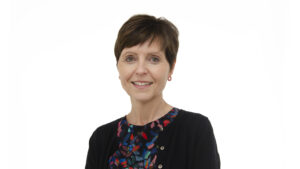This is the eighth post in a new series of perspectives from some of Publishing’s leaders across the non-profit and profit sectors of our industry. How did these leaders get into publishing? What excites them? What is their vision for the future of publishing, and indeed for the business and careers of all those working at their organization? We rarely gain these insights so we are excited to give voice to some of the key leaders in the academic publishing world.
Today, we talk to Antonia Seymour, Institute of Physics Publishing (IOPP) based in Bristol, UK.
 What was your route into publishing? Could you tell our readers a little about what drives you as a leader of IOPP?
What was your route into publishing? Could you tell our readers a little about what drives you as a leader of IOPP?
It was a very deliberate decision for me to pursue a career in scientific publishing. I did English, Art, Biology, and Chemistry at A level and read Biological Anthropology at Cambridge. When I plugged my educational background into a career search tool in my final year of university it came up with scientific publishing. I immediately started exploring the scholarly publishing sector and concluded it was the perfect way to combine my creative side with my love of science. From university I went on to do a Postgraduate Diploma in Publishing and got my first job at Harcourt Brace as a Journal Production Editor working on the Journal of Human Evolution. It was my dream job straight out the gate and I’ve never looked back.
The outputs of science are all-pervasive — scientists change the world. It’s their curiosity and their passion for answers that drives them. That’s the same for me – I want to solve problems and do things better than I did them yesterday. That’s what gets me out of bed every day. Publishers help scientists grow their knowledge and understanding of the world, so my job is to ensure IOP Publishing has the purpose, direction, and motivation to partner with the scientific community to advance knowledge and change the future for the better.
As a leader in academic publishing, what most excites you right now?
Science as the greatest collective endeavor. We are entering an exciting new era powered by science, engineering, and technology at a time when there are great opportunities and important choices facing society. All over the world, governments are placing an emphasis on ensuring their nation is innovation-driven and that their science and technology expertise is being used to solve challenges and develop new sources of growth and prosperity. Indeed, the UK government is a recent example of how science and innovation is being put right at the heart of government with the establishment of a new Department of Science, Innovation, and Technology to drive its superpower vision. In the US the Biden-Harris administration has announced a series of new actions to advance open and equitable research and to accelerate discovery and innovation in its Year of Open Science.
Scientific publications are an integral part of that global science system, validating, curating, disseminating, and reporting on those outputs. As the world’s research output continues to grow in volume every year, the role of scientific publications in ensuring trust and access to science has never been more critical.
How is IOPP positioned to serve the next generation of students, researchers and professionals?
We’re uniquely placed as a community-focused, society-owned publisher. The measure of our success is the success of the scientific communities we serve. Our products and services must develop and evolve to ultimately help researchers maximize their contribution to the world’s scientific understanding. The move to open science reinforces our core purpose as a learned society, which is the advancement and dissemination of knowledge and education.
Conducting science more openly can accelerate scientific discovery. But validation and filtration services are still needed so users can have confidence and trust in the information they’re consuming in a world of misinformation and fake news. At the moment, the validation and filtration services we provide are peer review and journal brands. But what could that look like in the future? What can we do differently to improve scientists’ ability to discover, read, interpret, share, and build upon the outputs of scientific research? However those services evolve and change, there is always going to be a cost to providing them well and at scale. With IOP Publishing, all the proceeds we make go back into physics. So we’re building communities, not just serving communities, which makes us a force for good. I firmly believe that higher order benefit is going to make us an even more attractive partner to the next generation of students, researchers, and professionals.
What do you anticipate the major challenges will be for IOPP, and indeed the publishing industry, over the next five years
The sector-wide shift towards open access is a huge opportunity for us at IOP Publishing, but it doesn’t come without its challenges. We share the ambitions of policymakers and funders, and we know that the support from researchers for an open future is there. A global study that we carried out with other society publishers found that over half of physical science researchers want to publish open access. Yet 62% of respondents also told us that a lack of monies from funding agencies prevents them from doing so.
There are a range of models being deployed to recoup the investments that publishers make into the management of peer review and ensuring quality research outputs. Gold open access to the Version of Record delivered through institutional agreements is emerging as the most prominent model, and for good reason. It’s financially sustainable at scale; it empowers authors because they don’t need to find the funding themselves; it delivers universal access to authoritative and credible research; and it provides the exposure that researchers crave — with articles published on an open access basis at IOP Publishing downloaded 80% more and cited 30% more than articles behind paywalls.
As we all set our sights on a fully open world and the benefits it undoubtedly brings, the concern remains that researchers from less wealthy countries and institutions or those working in less well funded disciplines could find themselves locked out of being able to publish open access. It’s going to take a concerted effort to put in place broader global financial support for open access above and beyond the article publishing charge discounts and waivers that publishers have already put in place.
What does OA/PA (open access/public access) mean for your business?
In a pay to publish model, the experience that an author has with us becomes the focal point for the entire business. This is where our community-roots really come to the fore. We continually look at how we can improve our publishing services, how we combine rigor with efficiency and speed, and how we ensure the highest integrity standards. It’s about attracting and retaining more authors through service excellence.
Encouraging open access uptake through transformative agreements (TAs) is also high on our agenda. In 2022 we signed more than 70 new agreements, taking the total number of institutions under a TA agreement to more than 700. For TAs to deliver on their promise of enabling open access at scale, they must deliver on the basic notion of transformation as a first principle. At IOP Publishing, our starting point is to offer unlimited read and publish TAs which foster a dramatic shift towards open access publishing. As policies and funder mandates to publish open access increase, TAs with unlimited open access publishing in any IOP Publishing journal offer authors a simple route to compliance and moves subscription funds to publishing.
What publishing innovations are you most proud of?
In 2020 we launched a first-of-its-kind peer review training and certification program, the only one in the world designed specifically for the physical sciences. Co-delivered by top-level physicists, it offers a unique blend of online learning and hands-on peer review experience and gives early career researchers the ability to review with confidence. When we introduced the program, our goal was to increase trust and standardize the quality of the peer review process. Fast forward a couple of years and we’ve achieved that in spades. To date, over 10,000 researchers have achieved IOP trusted reviewer status demonstrating an exceptional level of peer review competency. We’ve also had over 4,000 researchers sign up to our state-of-the-art e-learning hub, which delivers an ‘always-on’ and fully interactive learning experience with module-by-module courses streamed seamlessly online.
I’m also proud of the decision we made to move all our IOP owned journals to double anonymous peer review in 2020. We believe that keeping both the author and the reviewers anonymous will mean the research is judged more fairly, giving authors a better chance of impartial evaluation. It is part of our dedication to tackle the significant gender, racial and geographical under-representation in the scholarly publishing process.
We’re also offering transparent peer review which involves publication of the complete peer review process, from initial review to final decision. This means that alongside the published article, readers can see a full peer review history including reviewer reports, editor decision letters and the authors’ responses. Making this process visible to the community increases accountability and allows reviewers to be recognised more for their hard work.
Transparent peer review complements double anonymous peer review, with double anonymous peer review applied before publication, and transparent review delivered post-publication. Together these two processes allow for maximum objectivity during the review process, and maximum transparency after publication.
What is the future of hybrid/remote working at IOPP?
Following two – very long – pandemic years, the world of working has been transformed and we’ve fully embraced that change. In September we opened our new and re-imagined offices in the UK, China, and the US. Designed with flexibility and connection in mind, our ambition was to create offices that colleagues want to use, rather than ones they feel they have to. We’ve brought in comforts associated with working from home; good coffee in our cafe, comfy lounge areas, and space for quiet work. Colleagues now work from where they feel they can be most productive. The feedback has been overwhelmingly positive, and it’s been a highlight for me to see so many colleagues enjoying the offices and knowing that we have the smart technology in place to seamlessly connect everyone around the world.
What do the next generation of academic publishing jobs look like to you?
We’ll always need a strong mix of skills with people who truly understand the scientific community, who have the skills and expertise to guide researchers through the publishing and peer review process, and who listen to colleagues and customers and apply the information to deliver exceptional services. We need to be able to show our customers we know them, and that means colleagues being equipped with hindsight, insight, and foresight with extensible customer and market intelligence to test hypotheses, measure performance, and drive business objectives. It will require colleagues to be fluent in technology and data as enablers of our future success.
Discussion
1 Thought on "Chefs de Cuisine: Perspectives from Publishing’s Top Table — Antonia Seymour"
“We continually look at how we can improve our publishing services, how we combine rigor with efficiency and speed, and how we ensure the highest integrity standards. It’s about attracting and retaining more authors through service excellence” and, “We’re building communities, not just serving communities, which makes us a force for good”; two of my favourite quotes from this Antonia Seymour interview.

